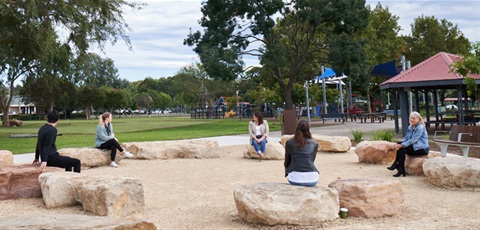Yarning and sharing

Historically, Campbelltown was a gathering place for mobs from around the region to come together, and this is still the case today.
Campbelltown, in its contemporary form, is a place where Aboriginal people from Country all over Australia have joined together as one community.
Despite coming from different mobs, having different stories, and different connections to Country, the Aboriginal community of Campbelltown is one guided by a deep respect for history and traditional ownership of the land. The ability to connect with one another is essential to establishing a sense of community. The connection that community have with each other is strong and at the heart of cultural expression.
The ways that people connect to each other are through yarning and sharing – sharing their own stories and the stories of their mob. To connect to one another through yarning is to also share and pass on knowledge.
The Yarning Circle at Koshigaya Park
A meeting place for the local Aboriginal and Torres Strait Islander communities as well as the wider Campbelltown community.
The Yarning Circle at Koshigaya Park in Campbelltown offers the opportunity to come together in a special place to have a chat, have a yarn, to meet with your family and friends, meet with your colleagues or as a place to share to learn.
This sharing of knowledge with each other, knowing where people come from and how they relate to one another, is a big part of the identity of the community. This also means educating one another and in particular the younger generation, about the stories of the Dharawal people, Dharawal land and about how Campbelltown came to be as it is today.
The space was developed as part of the Campbelltown 2020 program and features a prominent series of artworks and carvings depicting the lyrebird which in an Aboriginal Dreaming story that tells the story of the lyrebird as being an animal that was able to communicate with all the other animals to resolve disputes.
Other features include a series of sandstone rocks, bush tucker tree plantings and messaging in Dharawal language.